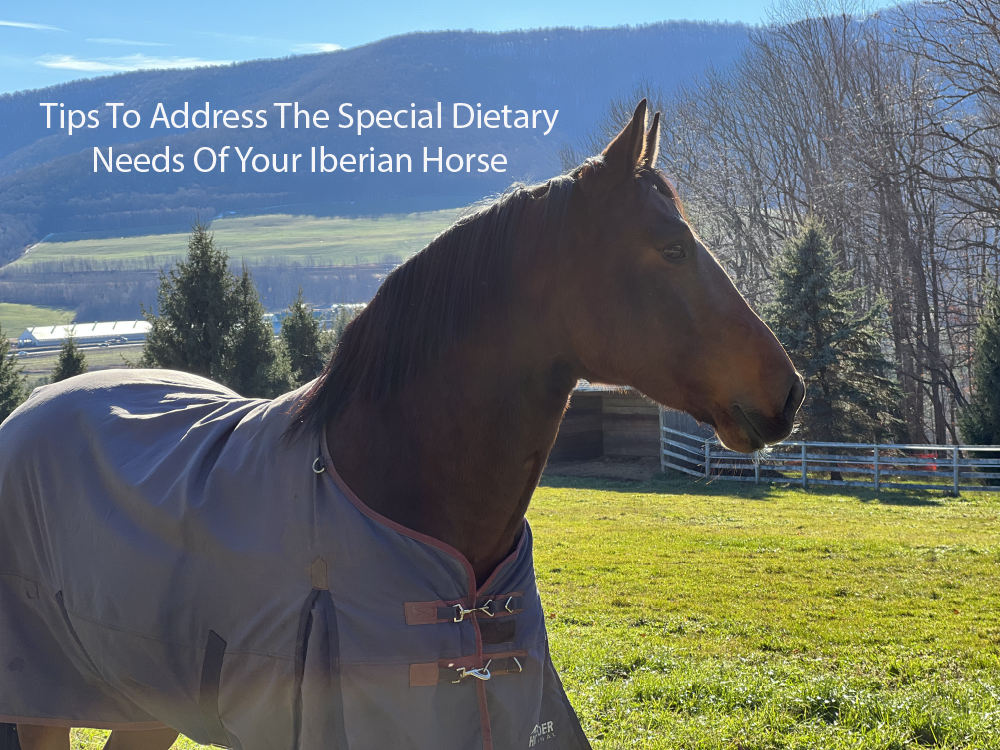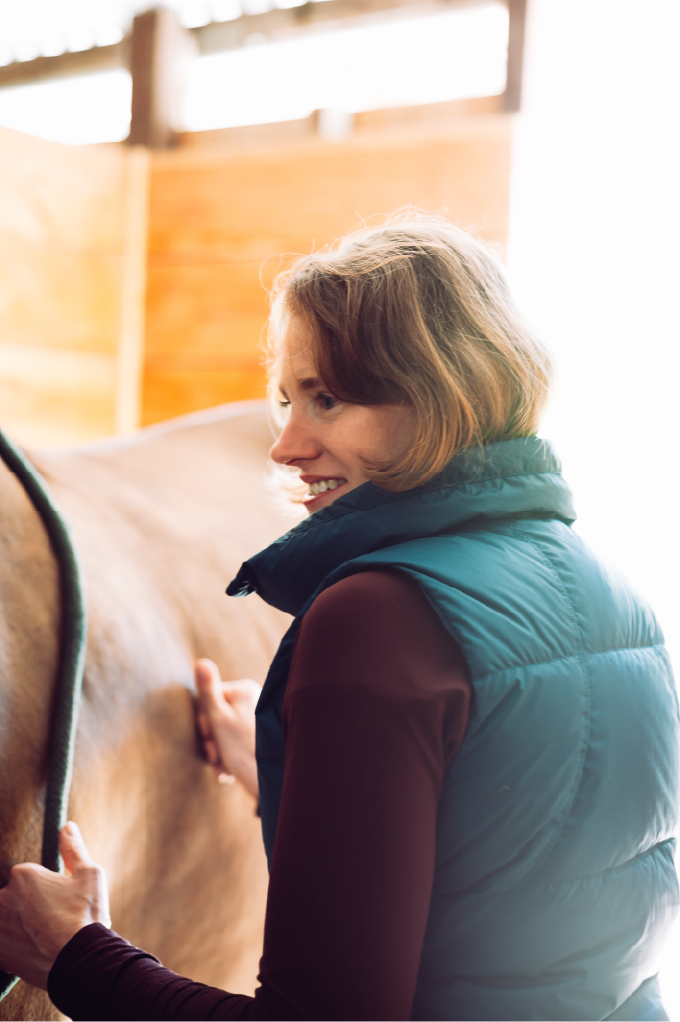Tips To Address The Special Dietary Needs Of Your Iberian Horse

Iberian horse ownership is rapidly on the rise in the U.S.A., and along with the beauty of the historic breeds of the Lusitano and Andalusian, comes new territory for the horse owner when feeding time rolls around for their equine charges.
A common problem many Iberian horse owners experience is their horses becoming overweight or even obese. The rich, lush grass pasture may not be the Iberian horses usual feeding ground especially if a recent import or if the horse in question is just a few generations down from a foreign bred animal. To keep an Iberian horse in tip-top performance condition and good health necessarily requires a few adjustments to the horse-keeping routines and feeding practices that are standardly utilized on this side of the pond.
A guiding light to help the Iberian horse owners navigate the large ocean of options in horse care is Meredith Crawford. Meredith has long been obsessed with all things Iberian horses, horse diets and management. Believing that food is medicine, Meredith has overcome her toughest training challenges through adjusting her horses’ diets and supplementation. She is a certified herbalist who has studied equine nutrition and has developed a line of mushroom supplements expected to be released Fall 2024.
Catskill Horse magazine’s Nikki Alvin-Smith, who is also an Iberian horse breeder and horse trainer, was thrilled to sit down with Meredith and conduct this interview. Readers please enjoy learning from her experiences and her generous sharing of important resources for further research as you need it.
Nikki: With the heritage of Iberian horses, Lusitanos and Andalusians, what special needs would you say they have in regard to nutritional needs compared to other breeds such as warmbloods for example?
Meredith: When we think of the heritage or ancestral diet for Lusitanos (PSLs) or Andalusians (PREs), we look to former and contemporary feeding practices on the Iberian Peninsula. Here, it’s important to acknowledge feeding differences between Portuguese, Northern and Southern Spain.
My vet in Portugal, João Crespo, published an article series for buyers importing Lusitanos from Portugal. In the article series, he provided the breakdown of ancestral vs. contemporary feeding practices as -
➔ Previously: fed forage with 2% protein and concentrates with high (15%) protein and starch
➔ Currently: fed forage with 6-11% protein levels and concentrates with lower (11%) protein and starch
Read his blog articles here:
Part 1 - https://www.lusitanohorsefinder.com/feeding-your-lusitano/
Part 2 - https://www.lusitanohorsefinder.com/how-to-feed-your-lusitano/
In the south of Spain, including Andalucía, horses are primarily fed oat hay and bedded with straw. Some of the Spaniards there will raise them on dry lots and use straw for feed - supplemented with raw cereal feed like oats, although many now feed a commercially formulated feed like Pavo or Cavalor to provide nutrients.
The northern part of Spain is the primary hay growing region in the country, similar to the Pacific Northwest or swaths of New England in the US. Horses grow up in fields until riding age, where they move into stalls bedded with straw or a small amount of shavings underneath straw. Hay is a local grass hay - I haven’t been able to determine the exact transferable species to the US, but from what Spanish colleagues have said, it’s akin to clover/coastal/Bermuda grass species here.
Across Spain, feeding supplements is rare, particularly at the large studs. Alfalfa exists but is not commonly fed to horses.
 In consulting with a former colleague in Spain - broker Jane Noughton - to articulate differences I’ve observed working and traveling around Spain, she affirmed what I saw is an accurate representation of feeding practices over there. Jane also informed me that as a result of ongoing drought concerns in Spain, current hay prices have risen to 8 EUR (!) a bale, causing concern for some of the smaller breeders. Not enough hay on the domestic market, hay is now being imported from Northern Europe, from as far away as Germany. It will be interesting to see how the Spanish horses adapt to the hay difference and if longer-term feed changes will occur as a result.
In consulting with a former colleague in Spain - broker Jane Noughton - to articulate differences I’ve observed working and traveling around Spain, she affirmed what I saw is an accurate representation of feeding practices over there. Jane also informed me that as a result of ongoing drought concerns in Spain, current hay prices have risen to 8 EUR (!) a bale, causing concern for some of the smaller breeders. Not enough hay on the domestic market, hay is now being imported from Northern Europe, from as far away as Germany. It will be interesting to see how the Spanish horses adapt to the hay difference and if longer-term feed changes will occur as a result.
All this is to show that we are dealing with horses who are used to consuming considerably less protein and sugar than their Northern European and US-based counterparts.
Available Forage in US - (CP = Crude Protein)
Orchard - 16% CP
Timothy - 17.5% CP
Oat - 9.5% CP
Alfalfa - 22% CP
Coastal / Bermuda - 12% CP
Source: University of Florida IFAS https://blogs.ifas.ufl.edu/marionco/2018/11/01/select-horse-hay/
Concentrates -
Triple Crown 30% - 30% protein levels
Purina Low Starch L/S - 12% protein, 12% starch + sugar
International Companies -
Cavalor Strucomix - 10% protein
Cavalor Tradition Mix - 13% protein
Hygain Zero Ultra Low Starch - 15% protein
Pavo SportsFit - 14% protein, 28% sugar + starch
[Starch and sugar amounts are not required to be on feed labels.]
In light of this dietary heritage, problems arise when we feed rich foods to horses accustomed to thriving on poor diets. Remember, there’s a reason these horses thrived when they found their freedom in North America and became our Mustangs.
Nikki: I read that Andalusians in particular are prone to laminitis and metabolic issues as a result of not being able to digest a certain protein found in grass? Can you tell us more about this and please feel free to be as technical as possible/our audience is quite informed.
Meredith: While a correlation between PREs and protein is not known among the dietary research groups I consulted for this article, a recent (2022) study done at the University of Kentucky shows the correlation of protein and insulin-resistance. The researchers in this study found that protein creates the same insulin spike as sugar in a horse’s diet. What this means is that an insulin-dysregulated horse (IR/EMS) can develop laminitis and other metabolic issues from an overabundance of protein - just as they can from an abundance of sugar and starch. Hence, feeding a PRE a protein-rich food (like alfalfa - ~20% protein) could cause laminitis. They’ve discovered laminitis is better correlated to an insulin spike in the horse's system, rather than an individual dietary component (i.e. starch, sugar, or protein).
Read the study here: https://www.frontiersin.org/articles/10.3389/fvets.2022.896220/full
While many like to focus on Iberian horses and their predisposition to metabolic issues, there are two other health concerns that need to be taken into consideration when creating a diet:
Polysaccharide storage myopathy (PSSM) / exertional rhabdomyolysis (ER) are disorders of muscle glycogen metabolism that are common within specific breeds. PSSM is found in PREs, however at a lower rate than in other breeds (i.e. Arabians, QH, warmbloods, draft breeds, etc.). [60% occurrence in PREs vs. 75% in warmbloods in one study done - https://www.proquest.com/openview/53b2c93d09592d95ac377750f37c51b1/1?pq-origsite=gscholar&cbl=2041027]
Also see: https://ker.com/equinews/muscle-disorder-breed-prevalence-studied/
Although there is no cure, the disease can be managed by diet and lifestyle. The current feed guidelines are to give less than 10% NSC and encourage frequent movement. Oftentimes, horses are found to improve when supplemented with Vit E and omega 6 and omega 9.
The other disorder known to affect PREs is Equine NeuroMuscular Disorder, in which horses exhibit shivers-like symptoms, with muscle twitching and wasting away. In a study done by the University of Cordoba, a correlation was made between young horses with restricted pasture grass access, vitamin E deficiency and this disease. Some (but not all) responded to vitamin E supplementation.
Nikki: What actions would you suggest that owners of Iberian horses take in regard to the care and management of these horse breeds to mitigate the risk of these metabolic issues occurring?
Meredith: Mitigating metabolic issues for an Iberian is similar as with any horse - keep hay NSC + starch amounts low, watch protein level (11% is the benchmark I use, as I mostly work with imports; US-based vets and farriers currently use 10% NSC), use slow feed methods, stick to an anti-inflammatory diet and use fat (rather than protein, sugar or starch) as the main source of fuel.
While what is included in an anti-inflammatory diet can vary somewhat by vet, the basics of it are:
-No sugar, including: Molasses, Cane Molasses, Molasses Products
-No soy, including: Extruded Whole Soybeans, Dehulled Soybean Meal, Plant
Protein Products, Soybean Meal, Soybean Oil, Soybean Hulls, Vegetable Oil, Lecithin
-No by-products, including: Processed Grain By-Products, Wheat Middlings, Distillers
Dried Grains, Wheat Millrun, Corn Gluten Meal, Roughage Products, Oat Hulls, Rice Hulls
-No cereal grains, including: Oats, Corn, Barley, Rye, Wheat
Others lists include rice bran, beet pulp and flax and linseed on the “do not feed” list, as they are tied to stomach inflammation. s
Additionally, I like to address the muscular diseases by feeding additional Vit E and Omegas - I feed Emcelle Vit E and Camelina oil
Also, I feed proactively to reduce stomach inflammation and oxidized stress:
-Aloe Vera juice
-Peppermint herb
-Traditional Medicinals’ OrganicThroat Coat tea (contains marshmallow root and slippery elm bark)
-Reishi fruit body (sporadically - not something a horse should be on year-round)
My Iberians also tend to do especially well on a mushroom supplement. I make my own (supplement line launching late 2024), but feeding straight dried Reishi fruit body periodically helps to eliminate the effect of oxidized stress on the horse’s brain and body. [Not good to leave on the supplement all the time]
Furthermore, I also use ACV for transitioning new imports to US hay - studies among humans diabetics show vinegar taken with a meal inhibits the body’s ability to generate an insulin spike. As with humans, it’s not a long-term maintenance strategy, but I use it during periods of transition (such as from Spain to the US, and transitioning between hay cuttings, etc.).
Refer to human research: https://www.ncbi.nlm.nih.gov/pmc/articles/PMC4438142/
Nikki: For Iberian horse owners in the North East or areas that have pasture turn out with green grass, versus those kept in Texas or FL, CA etc. where grass is not usually as readily available, what can they specifically include feed supplement or feed wise to help defray the issue/enhance protein digestibility ability in their horses?
Meredith: As touched on in the other questions - it’s not an issue of protein digestibility, so much as it is about insulin spikes.
Strategies that owners can use:
➔ Movement - track systems or having a grazing buddy
➔ Constant access - insulin spikes during a routine of feast/famine (i.e. fed 2-3x/day) rather than having constant access to
➔ Pasture management - counter-intuitive, but long pasture grass contains less sugar than several-times-eaten-over grass. Rotate access to grazing areas to keep grass tall.
➔ ACV during transitional periods to help mitigate insulin spikes as feed changes
➔ Think in averages - if you know your horse is going out on pasture grass, then feed a forage and a concentrate that has lower protein/sugar/starch amount than the pasture grass. Ex: feeding alfalfa would increase the average amount of protein your horse gets each day, while something like oat grass would decrease the average daily protein intake.
➔ Be smart about transitioning to grass and consult your vet. Not every horse is suited for living out on green grass pasture.
Having traveled to several breeding farms in southern Spain - Andalucía, Murcia - I saw mares and foals kept on what we could call small dry lots or large paddocks. There’s not a lot of room for movement and at the farms I visited, pasture grass was the exception, not the norm. Since horses in the region tend to have the lowest protein/NSC+starch diets on the Iberian Peninsula anyways, I advocate being very intentional and deliberate about how horses from that environment are transitioned. Certainly, consult your vet.
 Catch Up With Meredith
Catch Up With Meredith
Meredith lives in the San Francisco Bay Area with her husband, Yoel, her horses HGomez (PSL) and Relevate (PRE) and their cat, Kitty.
If you would like to learn more about equine nutrition and Meredith’s professional services, please reach out to her directly at https://thelab.horse for early access to supplements (still a couple beta tester spots available) or for guidance on supporting your horse’s wellbeing through diet. You can also catch her hosting the SoulBodyHorse podcast (listen anywhere podcasts are streamed).


